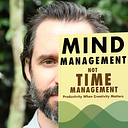Complexity is creepy: It’s never just “one more thing.”
We’ve all worked on projects that never seem to end. Every time you think you’re done, you realize you’re not.
There’s “one more thing” you or your client wants to add. Somehow, you get exhausted and your work suffers. Sometimes you simply burn out and move on to something else.
Why does this happen? Why do we consistently underestimate how much extra work it is to do “one more thing?”
It’s because complexity is creepy. Not “creepy” in an axe-murderer type of way, but in a vines growing on the side of a tree—eventually suffocating it—type of way. If you aren’t careful, complexity creeps its way into everything, and arrests your growth.
To understand how complexity creeps up on us, imagine you’re in a room with thirty-five other people. What are the chances that two of you have the same birthday?
If you do some quick mental math, you’ll probably guess that there’s more-or-less a ten percent chance two people in the room of thirty-six have the same birthday.
There’s 365 potential birthdays (there are no leap years in our theoretical world). There’s thirty-six people in the room, including yourself. 365 divided by thirty-six is about ten. So, a ten percent chance, give or take a few percentage points.
In probability theory, they call this the “birthday problem,” or the “birthday paradox,” and it illustrates why we don’t catch complexity before complexity catches us.
Intuitively, you know that the quick mental math example above is wrong. Intuitively, you know the odds are higher than ten percent that two people out of thirty-six have the same birthday. But most of us fail to recognize just how much higher the actual odds are.
To actually calculate probability in the birthday problem, you don’t simply divide the number of all possible birthdays by the number of people in the room.
The actual math too tedious to describe here. What’s important to understand is that each person’s birthday interacts with each other person’s birthday.
If you’re person one, the chances that person two has the same birthday as you are not high: about 1/365—roughly a 2.7% chance. But we’re looking for the chances that any two people have the same birthday. So each person that’s added to the room increases those chances.
At ten people, the odds have jumped to 11.7%—even more than our rough-math calculation for thirty-six people. At only twenty people: the odds are a whopping 41.1%!
In our example of only thirty-six people, it turns out that it’s almost certain that two of them have the same birthday. The exact odds are an 83.2% chance that two people out of thirty-six have the same birthday.
We’re bad at seeing complexity. This is why when we add onto a project it makes that project much harder to complete than we expect.
Jason Fried is great at catching complexity creep. His software product, Basecamp, is famous—some might even say infamous—for its simplicity. When Basecamp first launched, they refused to even add a due-date function—a bold move for a project management platform.
But, that was fourteen years ago, and the company is still going strong. So, they’re doing something right.
On my new podcast conversation with Jason, he explained why he’s wary of “one more thing:”
Every additional thing now interacts with all the other things…. Let’s say you have ten things, now you add an eleventh. It’s not “one more thing.” It’s one thing that interacts with ten other things. —Jason Fried, CEO of Basecamp
If you think about projects the same way you think about solving the birthday problem, you begin to see how projects can balloon in complexity each time you add “one more thing.”
Each interaction of that one thing with each other thing that already exists is another opportunity for slowdowns and complications. As Jason put it “you just added ten additional layers of things that could go wrong or things that can happen or things that you may not have considered, or edge cases.”
To escape the creep of complexity, think about how each thing you add to a project—or to your life—interacts with everything else:
- When you add a new tool to your workflow, that tool has to work with everything else in your workflow. It’s more opportunities for compatibility issues, servers going down, or billing issues.
- When you add a habit to your life, that habit has to fit in with everything else going on. It’s more opportunities to break still-budding habits. It’s more opportunities to feel like you’ve failed, something you want to avoid in order to build good habits.
- When you buy a new possession, that adds complexity to your life. You have to find a place to put it, amongst all of your other things. It’s one more thing for you to worry about or misplace or break.
Fight against your natural shortcomings in recognizing complexity, and everything will go more smoothly. You’ll get more done, you’ll be more focused, and you’ll breathe easier.
Want to 4x your creative productivity? Download your free toolkit »
